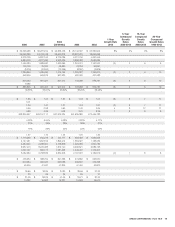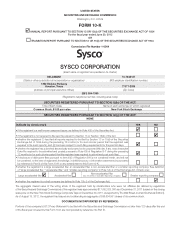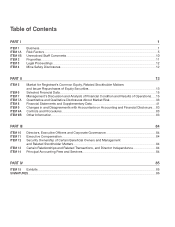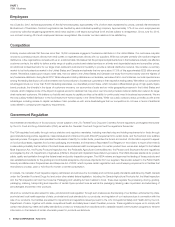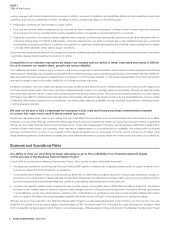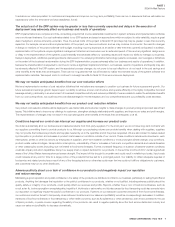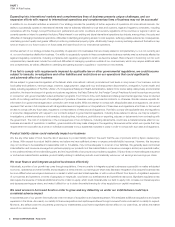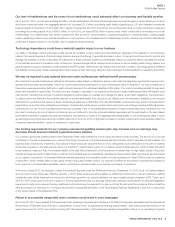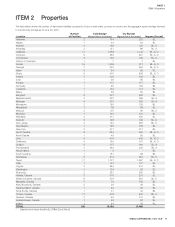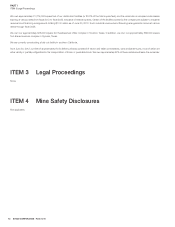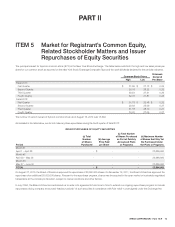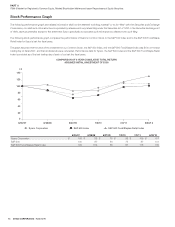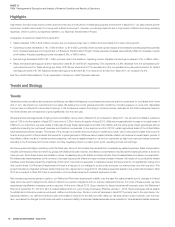Sysco 2012 Annual Report Download - page 29
Download and view the complete annual report
Please find page 29 of the 2012 Sysco annual report below. You can navigate through the pages in the report by either clicking on the pages listed below, or by using the keyword search tool below to find specific information within the annual report.
SYSCO CORPORATION-Form10-K6
PARTI
ITEM1ARisk Factors
ongoing sovereign debt crisis in certain Eurozone countries. In addition, our results of operations are substantially affected by local operating and economic
conditions, which can vary substantially by market. The diffi cult economic conditions can affect us in the following ways:
•Unfavorable conditions can depress sales in a given market.
•
Food cost and fuel cost infl ation experienced by the consumer can lead to reductions in the frequency of dining out and the amount spent by consumers
for food-away-from-home purchases which could be negatively impact our business by reduced demand for our products.
•Heightened uncertainty in the fi nancial markets negatively affect consumer confi dence and discretionary spending and can cause disruptions with our
customers and suppliers from tighter credit markets, temporary interruptions in our ability to conduct day-to-day transactions through our fi nancial
intermediaries involving the payment to or collection of funds from our customers, vendors and suppliers and/or liquidity issues resulting from an inability
to access credit markets to obtain cash to support operations.
This environment has adversely affected both business and consumer confi dence and spending, and uncertainty about the long-term investment environment
could further depress capital investment and economic activity.
Competition in our industry may adversely impact our margins and our ability to retain customers and makes it diffi cult
for us to maintain our market share, growth rate and profi tability
The foodservice distribution industry is highly competitive, with numerous regional and local competitors, and is a mature industry characterized by slowing
revenue growth. Additionally, new competition could arise from non-traditional sources, group purchasing organizations or consolidation among competitors.
New competitive sources may result in increased focus on pricing and on limiting price increases, or may require increased discounting. Such competition
may result in margin erosion and/or make it diffi cult for us to attract and retain customers.
Increased competition within the industry and general economic conditions have served to further increase pressure on the industry’s profi t margins, and
continued margin pressure within the industry may have a material adverse impact on our operating results and profi tability. Although our sales historically
have grown faster than the market, in recent years we have experienced slowing revenue growth. These trends have placed pressure on our profi t margins
and made it more diffi cult to achieve growth and pass along cost increases. We expect these trends to continue for the foreseeable future. If we are unable
to effectively differentiate ourselves from our competitors, our market share, sales and profi tability, through increased expenditures or decreased prices,
could be adversely impacted.
We may not be able to fully compensate for increases in fuel costs and forward purchase commitments intended
tocontain fuel costs could result in above market fuel costs
Volatile fuel prices have a direct impact on our industry. The cost of fuel affects the price paid by us for products as well as the costs incurred by us to deliver
products to our customers. Although we have been able to pass along a portion of increased fuel costs to our customers in the past, there is no guarantee
that we can do so again if another period of high fuel costs occurs. If fuel costs increase again in the future, we may experience diffi culties in passing all or
a portion of these costs along to our customers, which may have a negative impact on our business and our profi tability. We routinely enter into forward
purchase commitments for a portion of our projected monthly diesel fuel requirements at prices equal to the then-current market price for diesel. If fuel
prices decrease signifi cantly, these forward purchases may prove ineffective and result in us paying higher than market costs for a portion of our diesel fuel.
Business and Operational Risks
Our ability to meet our long-term strategic objectives to grow the profi tability of our business depends largely
onthesuccess of the Business Transformation Project
In fi scal 2009, we commenced our Business Transformation Project, which currently consists of three main components:
•
the design and deployment of an Enterprise Resource Planning (ERP) system to implement an integrated software system to support a majority of our
business processes and further streamline our operations;
•
a cost transformation initiative to lower our cost structure by $300million to $350million annually by fi scal 2015. These include initiatives to increase our
productivity in the warehouse and delivery activities including fl eet management and maintenance activities. It also involves improving sales productivity
and reducing general and administrative expenses, partially through aligning compensation and benefi t plans; and
•
a product cost reduction initiative which is designed to lower our total product costs by $250million to $300million annually by fi scal 2015. This initiative
involves the use of market data and customer insights to make changes to product pricing and product assortment. We believe there are opportunities
to more effectively provide the products that our customers want, to benefi t from our purchasing power and to create mutually benefi cial partnerships
with our suppliers. We believe that procuring greater quantities with select vendors will result in reduced prices for our product purchases.
Although we expect the investment in the Business Transformation Project to provide meaningful benefi ts to the company over the long-term, the costs
exceeded the benefi ts during the testing stages of implementation of ERP, including in fi scal 2012. We believe the costs will exceed the benefi ts in fi scal
2013. Successfully managing deployment is critical to our business success. While we expect all three components of the Business Transformation Project




